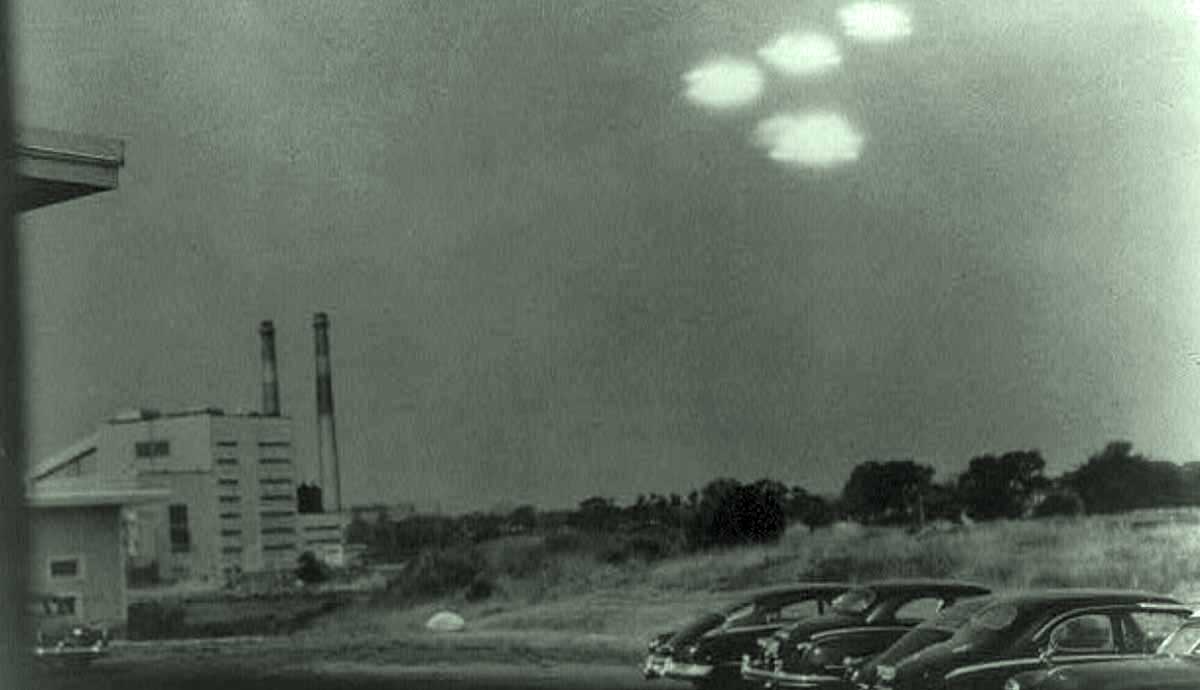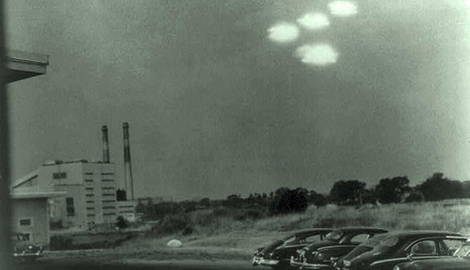
The United States Air Force was responsible for handling Project Blue Book, which investigated thousands of UFO sightings that were reported across the nation. The project took place over the course of two decades and attempted to identify flying saucer-like objects that were becoming increasingly common. Government officials were concerned that these objects were a threat to national security, especially due to heightened tensions from the Cold War. Controversy over UFO sightings and government involvement caused a public stir due to the lack of transparency initially provided by officials throughout the investigation.
The Creation of Project Blue Book

Increased sightings of Unidentified Flying Objects (UFOs) in the 1940s led the American government to launch a series of investigations to determine what the mysterious flying objects were. Project Sign was initiated by Air Force General Nathan Twining, the head of the Air Technical Service Command. The purpose of Project Sign, also known as Project Saucer, was to collect and evaluate all information and data relating to UFO sightings. With tensions of the Cold War rising in the late 1940s, there was concern between government officials about whether UFOs were a national security concern.
The date often associated with the beginning of the UFO phenomenon is June 24, 1947. On this day, private pilot Kenneth Arnold observed nine UFOs while in flight. Arnold was flying over Washington State near Mount Rainier looking for a downed US Marine Corps transport plane that crashed in the area. As Arnold searched for the downed aircraft, he spotted UFOs allegedly traveling at approximately 1,700 miles per hour. The term “flying saucer” appeared in news outlets following his report of the sightings. The event caused others to send in reports of sightings they witnessed in the months following. In 1947, there were 122 UFO sightings reported. Only 110 of the objects were identified, leaving 12 others unidentified. An increase in UFO sightings led the Air Force Chief of Staff to order an investigation into the phenomenon on December 30, 1947.

Project Sign was taken over by the Technical Intelligence Division of the Air Material Command (AMC), which was located at the Wright Field Air Force Base in Dayton, Ohio. The results of the projects concluded that UFOs were not a national security threat, and most UFO sightings were easily explainable. Reports drawn up by the Air Force determined that the UFO sightings were caused by mass hysteria, hoaxes, or known objects. Despite the conclusion that there was no threat from these sightings, it was decided that investigations led by the United States Air Force should continue.
Information and evidence collected during Project Sign and Project Grudge were transferred to a new UFO project launched in 1952, known as Project Blue Book. As the Cold War continued, so did UFO sightings. Air Force Director of Intelligence Major General Charles P. Cabell ordered Project Blue Book to investigate the UFO phenomena further. Official government involvement in investigating UFO sightings caused a public stir. It created the belief that UFOs were extraordinary objects, despite efforts to convince the public they were not. Investigation of UFO sightings across the United States and abroad would continue into the late 1960s until Project Blue Book was officially terminated.
Influence of the Cold War on UFO Sightings

Geopolitical tensions were high following World War II due to increased competition between the United States and the USSR. Worries over the international spread of communism and the race between world powers to have the strongest military system encompassed the Cold War. These heightened tensions influenced many policies and decisions made by the American government for several decades.
The United States Air Force was able to make sense of many of the UFO sightings that were reported between the 1940s and 1960s. However, hundreds of sightings remained unidentified. Officials in charge of the UFO phenomenon investigation were concerned that these unidentified objects were Soviet weapons. Although not directly involved in early investigations, the Central Intelligence Agency (CIA) kept track of the Air Force’s efforts on UFOs. A large influx of sightings occurred in 1952, reaching a total of 1,501 reports. This significant increase caused the CIA to get more involved in the investigation by launching a special study group. It was led by the Office of Science Intelligence (OSI) and the Office of Current Intelligence (OCI).
The CIA worked with the Air Technical Intelligence Center (ATIC) to monitor UFO sightings and their explanations. Great efforts were made to keep the CIA’s involvement in the UFO phenomenon investigation secret to prevent mass hysteria. This secret would later backfire as the public became highly skeptical that the CIA was also investigating UFOs and covering it up.
Objectives of Project Blue Book

Although early investigations of UFO sightings in Projects Sign and Grudge determined that the objects weren’t a national security threat, it still remained one of the main objectives of Project Blue Book. Each UFO sighting reported was investigated using various identification methods and data to rule out what the object was. However, some of the sightings lacked sufficient information and data for the Air Force to determine what the object was. Another main objective of Project Blue Book was to determine if the UFOs reported provided any scientific information or signs of advanced technology that could be useful for research.
Investigation of each UFO sighting was split up into three phases. The first phase was a preliminary investigation after receiving a report of a UFO sighting. Information was to be collected by the Air Force base nearest to the sighting that was reported. The information was relayed to the main headquarters of the Project Blue Book Office located at Wright Field, now known as the Wright-Patterson Air Force Base.
The first phase was designed to determine if the UFO was easily explainable. If the initial investigation proved unsuccessful, it moved on to the second phase. UFO sightings were more closely analyzed by the Project Blue Book Office during the second phase. Analysis of the reported UFO was done so objectively and scientifically and sometimes warranted the use of scientific facilities at the Air Force base. The Secretary of the Air Force and Office of Information stepped in if the object couldn’t be identified during the second phase. UFO sightings were organized into three different categories following an investigation. Identified objects were those that were able to be explained as a result of sufficient information.

Objects were placed in the category of “insufficient data” if a certain element of the investigation was missing to positively identify the object. Examples of missing data or information included the direction in which the sighting occurred, where the sighting occurred, and at what time, or how it appeared or disappeared in the sky. If a UFO was placed in “insufficient data,” another investigation was conducted to rule out whether or not it was a threat to national security. There were 12,618 total UFO sightings reported from 1947 until Project Blue Book was terminated in 1969. Out of these reports, 701 of the UFOs remained unidentified. Objects placed in the “unidentified” category had all the elements needed to make a positive identification of the object, but they didn’t correspond with any known objects based on the object’s description.
Most of the UFO reports were explainable objects. Some objects often reported as UFOs included astronomical bodies, balloons, aircraft navigation, beacons, and meteorological phenomena. The sources of UFO sightings reported came from a wide variety of individuals. Some reports came from pilots, amateur astronomers, and weather observers. Astronomical bodies were the most common cause of UFOs. Throughout the investigation, Air Force officials were to keep an open mind about what the unidentified objects could possibly be. This included considering the possibility of extraterrestrial life. However, information collected on each sighting didn’t provide any evidence that pointed to possible extraterrestrial life or vehicles.
Conclusions of Project Blue Book

Project Blue Book caused the public to lack trust in the American government due to the CIA’s attempt to keep their involvement in Project Blue Book a secret. Project Blue Book files were also classified for decades before being released to the public. In October 1966, the Air Force contracted the University of Colorado to conduct a study on UFOs. The study was handled by the Condon Committee and took place over the course of 18 months. The University of Colorado was rewarded with $325,000 to conduct it.
The head of the program was the former Director of the National Bureau of Standards and physicist Dr. Edward U. Condon. The study determined that “little, if anything, had come from the study of UFOs in the past 21 years.” The Condon Committee also determined that the most unlikely explanation for UFOs was extraterrestrial beings visiting Earth. The committee’s report also advised that further investigation of UFOs was unnecessary. As a result, Project Blue Book was officially announced as terminated by Secretary of the Air Force Robert C. Seamans, Jr. on December 17, 1969.

The Air Force and all other parties involved in Project Blue Book came to three main conclusions as the project was terminated. The first conclusion was that none of the UFOs reported and investigated indicated they were a national security threat. It was also determined that none of the UFOs were technologically advanced or highly developed beyond current scientific understanding. The final conclusion was that, despite lacking explanation, evidence of UFOs categorized as “unidentified” didn’t provide any evidence that indicated they were extraterrestrial.
The collection of Project Blue Book files was handed over to the National Archives in 1975. Following a series of redactions to protect personally identifiable information, the files were made available for public research in 1976. Despite the conclusions of Project Blue Book, questions surrounding the UFO phenomenon still emerge. Documentation released on Project Blue Book left many UFOlogists dissatisfied with the contents of the investigation. The conclusion of the Condon Committee was also questioned by UFOlogists, which were fueled by beliefs that the CIA was much more involved in the investigation than presented. Despite the extensive investigation of the UFO phenomenon, skepticism still remained among the science community that UFO sightings may have been extraordinary and pointed to signs of extraterrestrial life.










